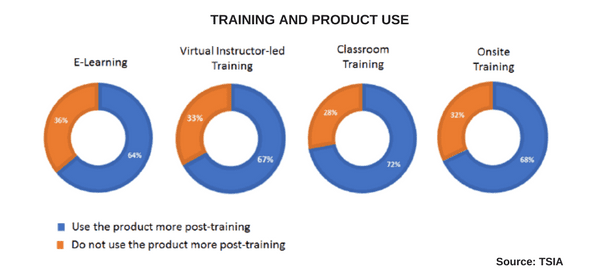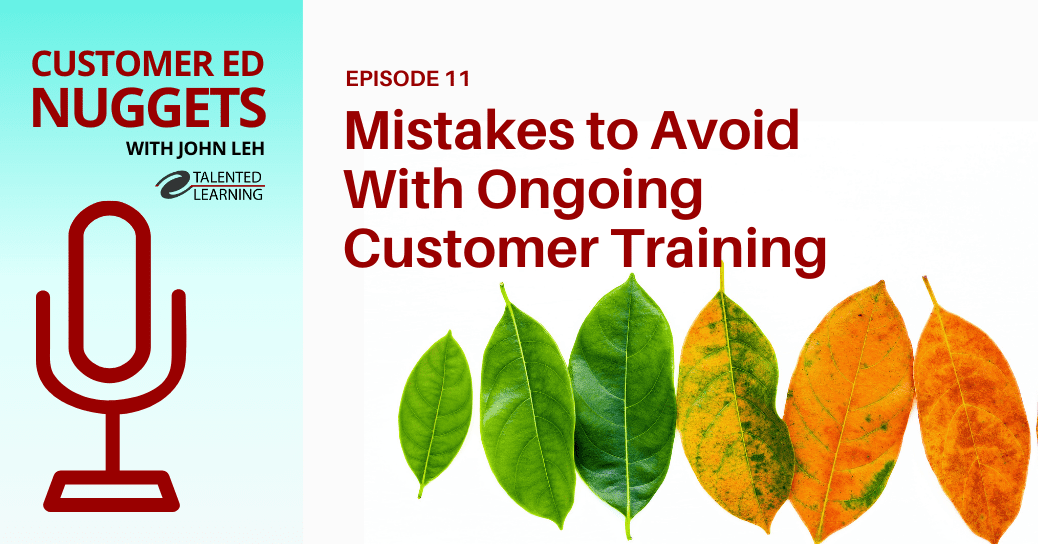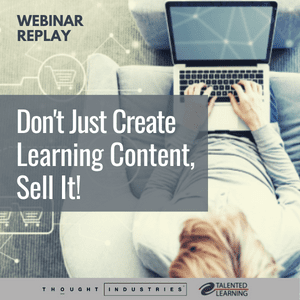
Over the past decade, businesses large and small have widely embraced customer relationship management systems (CRM), thanks largely to the remarkable rise of the world’s most popular cloud-based CRM, Salesforce.com. Most Salesforce users rely on this powerful software-as-a-service suite for its original purpose – centralized management and tracking of customer and prospect account information.
However, in recent years, many of these organizations have also integrated Salesforce with their learning management system (LMS) of record. This makes it easy to educate far-flung sales teams with relevant product and professional training, delivered directly through their CRM interface.
And now, learning organizations are discovering yet another significant business benefit from CRM-LMS integration – the ability to drive customer education. This kind of CRM-LMS integration is not about sales automation or sales enablement.
It’s about connecting directly with customers before, during and after a sale to facilitate product onboarding, feature adoption, ongoing engagement and overall customer success.
Customer Education: Where’s the Value?
What’s driving this surge of interest in CRM-enabled customer education? And more specifically, what can you achieve by integrating your LMS with a CRM like Salesforce?
Multiple studies show that educated customers are the most loyal and profitable customers. For example, according to recent research by the Technology Services Industry Association (TSIA), the average renewal rate among trained software subscribers is 92%, versus 80% for untrained customers.
The study also indicates that at least 64% of customers use products more after they participate in elearning, virtual instructor-led training, classroom training or on-site training.
Increased interest in customer education is reflected in the growing number of solutions designed specifically for this function. For example, let’s rewind a few years to the start of this decade, when nearly all learning systems were designed for employee compliance training. I could count on one hand the systems focused on some form of extended enterprise education.
But now, hundreds of niche learning systems are available for external audiences of all types – channel partners, franchisees, distributors, installers, technicians, developers, contract workers and of course, paying customers.
What to Expect From Customer Training
There are multiple reasons to invest in CRM-LMS integration to drive customer learning. For example, you can:
• Accelerate product adoption – The sooner your customers find value from using your product or service, the longer they’re likely to stay, and the more likely they are to continuing investing in your brand. Onboarding new customers and providing quick-start training is a great way to build engagement and drive adoption from the moment a sale closes.
• Retain revenue-generating accounts – According to Harvard Business Review, customers who rate a brand highly are likely to stay six times longer and spend up to 140% more than those with the poorest experiences.
This is particularly important for software-as-a-service (SaaS) applications and other online subscription businesses, where it’s relatively easy for customers to research and switch to other vendors. Ongoing education is an excellent way to reinforce relationships and keep customers coming back, year after year.
• Lock-in relationships through certification – Many companies (particularly those with complex technology products) have built training empires around product certification. Think Microsoft, Cisco, Oracle, EMC, Red Hat and Hubspot.
For customers, certification is a ticket to professional credibility and career advancement. For vendors, certification programs build tremendous brand loyalty and advocacy.
• Differentiate your brand – In today’s dynamic global marketplace, it can be difficult to stand out from your competition. But rather than providing a generic “one-size-fits-all” brand experience, you can combine LMS and CRM data to create a more personalized approach to customer success.
For example, by aligning customer education activities with specific points in a customer journey map, this framework can guide the timing and tone of targeted messages, such as cross-selling and up-selling communications.
• Reduce support costs – Every time a customer contacts your support team by phone, chat, or email, the cost of responding eats into your profit margins.
Although no one can eliminate support calls entirely, you can minimize the volume of basic inquiries by designing relevant learning content that gives customers the self-service tools they need to resolve questions in the moment of need. Fewer support calls and trouble tickets can translate into substantial direct and indirect cost savings.
How Does CRM-LMS Integration Improve Customer Training?
Successful customer education programs understand the logic that connects CRM and training data. If Salesforce is the engine that drives your organization’s customer relationships, all of your customer, partner and marketing data is captured there.
Chances are, you already use Salesforce reports to monitor and measure a variety of customer behaviors and trends such as:
- New customer acquisition rate and account value
- Repeat purchases and renewals
- Incremental purchases
- Complementary and cross-product purchases
- Support call or trouble ticket volumes
- Customer satisfaction scores
It makes sense to share all of this business-critical information with downstream systems — especially your LMS. Likewise, it’s important for your LMS to feed data into Salesforce about the volume and type of training your customers have received. By centralizing and linking this data, you’ll uncover connections between actions and outcomes that were previously difficult to identify.
For example, with Salesforce reporting or other analytics tools, you can quickly see whether trained customers are buying more, churning less or logging fewer support tickets.
However, as with any data-based insights, the most critical consideration is the quality of the underlying data in your CRM-LMS integration. Source data must be clean, accurate and reliable. It must also be made available in a way that works with your reporting and analytics tools.
One way to simplify CRM-LMS integration is to choose a solution from the Salesforce AppExchange. As the pervasive CRM in the market, Salesforce has created a vibrant marketplace where you can research and download third-party products that seamlessly integrate with the Salesforce platform.
While this isn’t the only way to achieve CRM-LMS integration, it is a convenient one-stop-shop for learning solutions that Salesforce has rigorously reviewed and approved.
CRM-LMS Data Insights: One Example
It’s one thing to anecdotally assume that better-educated customers are more likely to renew their subscriptions, or that training reduces the number of support tickets. It’s another thing to prove those assumptions with evidence.
But by combining CRM and LMS data, you can build a more intelligent, compelling case for any of the benefits I outlined above, and use that case to guide strategic planning and ongoing operational decisions.
For example, in addition to all the account data that Salesforce makes available to help maximize relationship revenue and loyalty, what if you also know which customers have earned a specific product certification level, and how far other customers have traveled on that same certification path?
What if you compared the expected lifetime value (LTV) of both customer groups, and your analysis revealed that those with certifications represent 10x more revenue and 2x more profit for your company? These insights can inform your decisions about which customers are worth targeting with incentives or rewards for completing certification milestones, and how much to invest in those offers.
What’s the Best Way to Start?
In a recent episode of The Talented Learning Show podcast, I spoke with Sandi Lin, CEO and co-founder of Skilljar, an award-winning cloud-based platform for customer onboarding, training, and engagement. Among other things, I asked Sandi how organizations can get started with CRM-driven customer training. Here are her top recommendations:
• Start small and drive impact – Don’t worry about perfection or building out a massive training curriculum with 50 courses. Get buy-in and adoption from your first customers, and go for an early win. Take an agile approach and just get started.
• Choose a solid early-stage technology platform – Avoid cobbling together a customer-facing LMS from scratch. You don’t need a high-end system, but you do need to provide a quality learning experience that will grow with you for the next two or three years.
• Know why you are providing customer training, and focus on key data – Anything you do that teaches customers how to use your product more effectively will lead to higher customer retention and value. But understand what you’ll measure to prove the ROI of your customer training program, and be sure at the outset that your system captures the data you need.
Conclusion
If your organization wants to foster more productive, profitable customer relationships, then customer training should be at the center of your business strategy. And if customer training is a priority, then integrating your CRM with your LMS should be at the top of your “to do” list.
Organizations with CRM-LMS integration can track and interpret customer and prospect behavior more efficiently and effectively. This, in turn, helps them engage these audiences in educational content that is more timely, relevant and useful. As a result, their sales cycles accelerate, customer churn shrinks, support tickets decrease and revenue streams expand.
As more organizations realize the benefits of customer education driven by CRM-LMS integration, we’re bound to see more learning solutions enter this space. On behalf of customers everywhere, we look forward to seeing what lies ahead.
Thanks for reading!
Share This Post
Related Posts
The Future of Customer Education: Customer Ed Nugget 16
Customer education is rapidly evolving as organizations embrace new strategies and tech. What does this mean for the future of customer education? See what experts say on this Customer Ed Nuggets episode
Education Strategy Mistakes to Avoid: Customer Ed Nugget 15
What does it take to deliver a successful customer education program? It starts with a solid education strategy. Learn how to avoid common pitfalls on this Customer Ed Nuggets episode
Which LMS is Best for You? New Shortlisting Tool for 2024
How can you find the best learning system for your business? Our LMS shortlisting tool can help. Learn about the 2024 RightFit Solution Grid. Free, reliable guidance based on our independent research
How to Build a Learning-Based Business: Executive Q&A Notes
Building and selling online courses may seem easy, but building a profitable learning-based business is far more complex. Find out what successful leaders say about running this kind of business
The Rewards of Community Building: Customer Ed Nugget 14
What role does community play in your customer relationships? Find out why community building is such a powerful force in customer education on this Customer Ed Nuggets episode
Benefits of Training Content Syndication: Customer Ed Nugget 13
If you educate customers online, why should you consider content syndication? Discover 10 compelling business benefits in this Customer Ed Nuggets episode
Top Marketing Skills to Master: Customer Ed Nugget 12
Successful customer education programs depend on professionals with expertise in multiple disciplines. Which marketing skills lead to the best results?
How to Measure and Improve Partner Training ROI
An educated channel is a successful channel. But how do you know if your educational programs are effective? Learn from an expert how to evaluate partner training ROI
Mistakes in Ongoing Customer Training: Customer Ed Nugget 11
Customer education doesn't stop with onboarding. It pays to invest in ongoing customer training. Learn which mistakes to avoid in this Customer Ed Nuggets episode















FOLLOW US ON SOCIAL